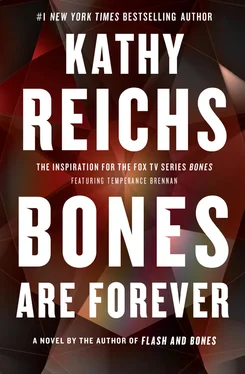“Annaliese Ruben?” Ollie called out.
Nothing.
“Ms. Ruben?”
No response. No sounds of movement.
As at the main entrance, Ryan and I moved to one side of the closed door, Ollie to the other. Ollie reached out and turned the knob.
The bathroom was impossibly small, the fixtures crammed into a space little bigger than a locker. Fully open, the door blocked access to the tub.
Cosmetics and body lotions lined the back of the toilet. A pink nightshirt hung from a hook beside it. Red and white towels filled a bar on one wall, carefully draped and alternating by color. The plastic shower curtain was, of course, red. The tile was spotless, the mirror and sink immaculate.
“Tidy lady.” Ollie’s words were edged with condescension.
“She’s doing what she can to make this a home,” I said.
“Tough job in this shithole.”
Ollie opened the medicine cabinet and started poking through the contents. The move annoyed me. “We came to find Annaliese Ruben. She’s not here. Let’s go.”
“You in a hurry?”
“Miller is not our concern. There’s no reason to invade her privacy.”
Ollie shot me an über-patient smile but closed the cabinet.
As I rejoined Ryan in the main room, I heard the sound of the shower curtain being pushed to one side.
“Now what?” I asked when Ollie reappeared.
He checked his mobile, apparently found nothing of interest. “Now we get some sleep. In the meantime, I’ll put eyes on this place and on Miller.”
“Someone should canvass out here tomorrow, talk to the owner,” Ryan said.
“Hadn’t thought of that, Detective.”
Ryan’s jaw did that clampy thing, but he said nothing.
Ollie crossed to the makeshift closet, flipped through the hanging clothes, toed the stacks, then knelt on one knee to peer under the bed.
“Check the microwave?” Ryan tossed the key not so gently onto the bureau.
Ollie ignored the sarcasm. “Let’s roll.”
We all trooped out.
* * *
At the Best Western, Ryan registered and disappeared.
“I’ll walk you to your room,” Ollie said when I had my key.
“No, thanks.”
“I insist.”
“I decline.”
“It’s a tough town.”
“I’m inside a hotel.”
Ollie raised the handle on my carry-on. I reached for it. He swiveled the thing into pulling position and gestured for me to proceed.
Seething, I set out across the acre of lobby. Ollie followed, wheels clicking on the tile. I unlocked my door in icy silence.
“Let’s shoot for eight tomorrow,” Ollie said.
“Phone if anything breaks.”
“Yes, ma’am.”
Ollie made no move to release my suitcase. Yanking the handle from his grasp, I took two steps backward and slammed the door.
The room was typical North American Motel. King bed, dresser, desk, upholstered chair. The drapes and bedding featured appropriately paired selections from the green quadrant of the color wheel. A framed print was bolted to each of the walls. Though the decor would never inspire coverage in Architectural Digest , the place was light-years upmarket from the Paradise Resort.
Not that it mattered. Face wash. Swipe at the teeth. I was out.
Minutes later, the Irish National Anthem blasted me awake. I shot a hand toward the nightstand. As my iPhone hit the carpet, the boys kept singing.
Groping in the dark, I found the phone and clicked on.
“Brennan.” Trying to sound alert. Pointless. It was the middle of the night.
“I hope I didn’t wake you?” The caller was female and speaking French. “It’s Simone Annoux.”
My semiconscious mind fumbled with the name. Came up blank.
“In the DNA section.”
“Of course, Simone. What’s up?”
As I switched the call to speaker, I noticed that the digits said six-twenty. Eight-twenty in Montreal. I’d been asleep almost four hours. I lay back and placed the phone on my chest.
“You submitted samples from an infant death case in Saint-Hyacinthe? When we talked, you mentioned that identity was an issue?”
Simone is a tiny woman with carrot hair, thick glasses, and the assertiveness of an earwig. Her excessive timidity results in the phrasing of most of her comments as questions. Drives me nuts.
“Yes.”
“We tried something a bit controversial. I hope that’s all right?”
“Controversial?”
“I thought you would want to know?”
“What did you try, Simone?”
“Are you familiar with BGA?”
“Ben Gurion Airport?”
“Biogeographical ancestry.”
“Tony Frudakis,” I said.
“Yes. And others. Though I believe Dr. Frudakis has abandoned this avenue of research?”
In the early 2000s, women were being murdered in Baton Rouge, Louisiana. Based on an FBI profile and one eyewitness statement, investigators sought a young white male as the serial killer. With no success. Frustrated, they turned to a molecular biologist named Tony Frudakis.
At that time DNA from a crime scene or victim could be used only for comparison to samples in CODIS, the Combined DNA Index System, a database containing approximately five million profiles. If investigators had a specimen but no suspect, they could run it through the database to see if it matched a sample on file.
While CODIS is good at linking unknown suspects to individuals already entered due to criminal activity, it’s useless for predicting ancestry or physical characteristics. And that’s no accident. When the National DNA Advisory Board selected the gene markers—the DNA sequences having known locations on chromosomes—for use in CODIS, they deliberately excluded those associated with physical characteristics or geographic origins. Couldn’t risk offending any ethnic group. No comment on that political reasoning.
DNAWitness, the test Frudakis developed and used in the Baton Rouge case, employed a set of markers selected precisely because they did disclose information about physical traits. Some were found primarily in people with Indo-European roots, others mainly in people of African, Native American, or South Asian heritage.
Frudakis told the Louisiana Multi-Agency Homicide Task Force that the perp they were seeking was 85 percent sub-Saharan African and 15 percent Native American. The Baton Rouge serial killer, linked by DNA to seven victims, turned out to be a thirty-four-year-old black man named Derrick Todd Lee.
“—distribution of these genetic markers has been associated with broad geographic regions, resulting in the recognition of BGA and the use of the markers as a major genetic component in the dissection of race. But you have to keep in mind that the diversity of these markers was complicated over the eons by historic events—population migrations, for example.”
While I’d been thinking about Frudakis, Annoux had gone into lecture mode. I heard no question marks when she talked science.
“People move around,” I said.
“Yes. Paleoanthropologists believe all modern humans are descended from populations that migrated out of Africa some two hundred thousand years ago. First they settled in the Fertile Crescent. Gradually, groups splintered off in every direction; eventually, some crossed the Bering Strait to America. With distance came reproductive isolation resulting in divergence of the gene pools.”
“What does this have to do with the baby?” It was way too early for discourse on evolutionary molecular biology.
“BGA markers can be used to determine what percentage of an individual’s DNA is shared with Africans, Europeans, Asians, or Native Americans. The technique has been used in a number of high-profile criminal investigations. Shall I explain the process?”
“Keep it short.”
“The test examines for the presence of one hundred and seventy-five SNPs called AIMs, or ancestry informative markers. Are you with me?”
Читать дальше









